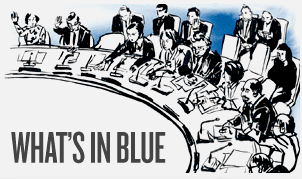Humanitarian Effects of Environmental Degradation on Peace and Security: Open VTC
Tomorrow (17 September), Security Council members plan to hold a ministerial-level open debate in videoconference (VTC) format on the humanitarian effects of environmental degradation on peace and security. Kalla Ankourao, Niger’s Foreign Minister, is expected to chair the meeting. The focus of the meeting, which is one of the signature events of Niger’s presidency this month, will be on the Sahel region and the Lake Chad Basin, although participants are also encouraged to broaden the geographical scope of the discussion. ICRC President Peter Maurer; Executive Secretary of the UN Convention to Combat Desertification (UNCCD) Ibrahim Thiaw; and UNCCD Earth Ambassador, artist, and activist Inna Modja will brief. Given the VTC format, non-Council member states are requested to submit their interventions in writing. These will be included in a compilation of briefings and statements from the meeting that will be incorporated in a Security Council document.
In describing the links between ecological challenges and conflict, Maurer is likely to share impressions of his recent visit to Burkina Faso and Niger, which concluded on 14 September. During the visit, he described how violence, climate change and COVID-19 had had a devastating impact on the Sahel, arguing that “it’s clear that this region of the world needs assistance to alleviate the crippling consequences of both armed conflict and climate risks”. Maurer may emphasise how climate change and other environmental factors exacerbate the humanitarian impacts of conflict. Thiaw may discuss the progress of the “Great Green Wall Initiative” launched by the AU, which strives to build a belt of trees and other vegetation across the Sahel from Mauritania to Sudan that is 15 km wide and 8,000 km in length. He may describe how this initiative is supporting the livelihoods of people in the region and strengthening their resilience to the humanitarian impacts of conflict. Modja, who participated in a recent documentary on the “Great Green Wall”, may describe how addressing drought, desertification and environmental factors is essential to the welfare and survival of people in the region. One or more of the briefers may describe herder-farmer conflicts over resources such as land and water in the Sahel as obstacles to peace in the region.
Niger has circulated a concept note in preparation for the meeting. It states that the session will provide Council members with the opportunity to address the links between armed conflict and environmental degradation—including factors such as desertification and soil erosion—and how such conflicts could be resolved. The meeting is also intended to focus on ways that member states and the UN system can counteract the damage done to the environment in armed conflicts.
A number of questions have been proposed in the concept note to guide the discussion. These are:
- How can the United Nations and the Security Council, in particular, better understand the humanitarian security implications of climate change and land degradation and integrate them into conflict prevention, peacekeeping and peacebuilding strategies?
- What can be done to address the linkages between the effects of the destruction of the natural environment in armed conflict, while building the resilience of populations to these risks?
- How can current climate mechanisms, international law, and policies be further adapted and implemented to better contribute to the protection of the environment and natural resources in order to prevent armed conflict?
Some members may emphasise how climate change worsens food insecurity and water scarcity in ways that have a devastating human toll, especially when combined with the impact of COVID-19. They hope to humanise the discussion by demonstrating the concrete impact of desertification, food insecurity, and water scarcity—factors that are often considered conflict “risk-multipliers”—on the lives of ordinary people. Some may argue that the negative impact of these factors on livelihoods helps enable recruitment into terrorist groups. There may also be references to the role of international law in protecting the environment in conflict situations.
Several Council members are likely to emphasise how environmental degradation can fuel violent extremism and inter-communal violence (including between herders and farmers) and jeopardise peace consolidation efforts. Other members with a more conservative view of what constitutes a threat to peace and security are likely to be more cautious about the Council engaging on the issue of environmental degradation in conflict.
On 25 September, Belgium, the EU, Niger, and the ICRC are co-organising a high-level event on the margins of the General Assembly general debate on “The humanitarian impact of combined conflict and environment risk”.

